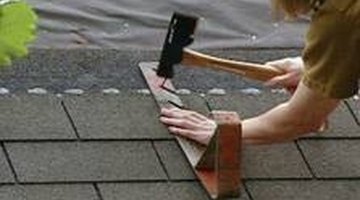How to Install Roof Jacks
The first issue on any roofing project is safety. Roofing shingles are laid starting at the low edges of the roof, from a ladder or scaffolding. Then you move upward on the roof. Once you're up on the slope, it's crucial to have something level to put your feet against.

The problem is, how do you nail up a brace to stand on without leaving nail holes in the roof? That's where roof jacks come in.
-
Lay the lower courses of your roofing from a ladder, until you can't comfortably reach up the slope of the roof to do it anymore, generally four or five courses.
-
Set your first roof jack in place near the edge of the roof, with the top span of metal positioned so that the row of diagonal slots on the jack is entirely on the top portion of the top shingle in the top course. This is the half of the shingle that will be covered by the overlapping course above it.
-
Put a nail at the top of each slot. Hammer the nail far enough down that it's flat with the metal of the jack, but don't pound it any harder than that. Repeat with another jack about four feet over, and another four feet over from that, until they're positioned across the roof.
-
Lay your 2x10 board onto two of the jacks. Use the board as footing as you're laying the next several courses of roofing, moving the board over to the next pair of jacks as needed.
-
When you can't comfortable reach up any further to lay another course of shingles, take the board off the jacks and use your hammer to pop each of the jacks upward at an angle, hitting it from the angle at the open bottom of the diagonal slots in the jacks. (You won't be able to see the slots because they will be covered by the shingles.) Slide the slotted bracket of the jack out from under the shingles, leaving the nails in place.
-
Lift each shingle where the nails are underneath, and give each nail one hit with the hammer to sink it to the level of the roofing. Move the jacks to the top half of the top row of finished shingles, and repeat the process.
Things You Will Need
- At least two roofing jacks
- Hammer
- Roofing nails
- 2x10-foot board
Warning
Always be aware of your surroundings and footing when working on a roof.
Photo Credits
- http://www.hometime.com/Hometime_4.0/media/howto/Roofing/Roof_Jack.jpg
- http://www.hometime.com/Hometime_4.0/media/howto/Roofing/Roof_Jack.jpg
More Articles



